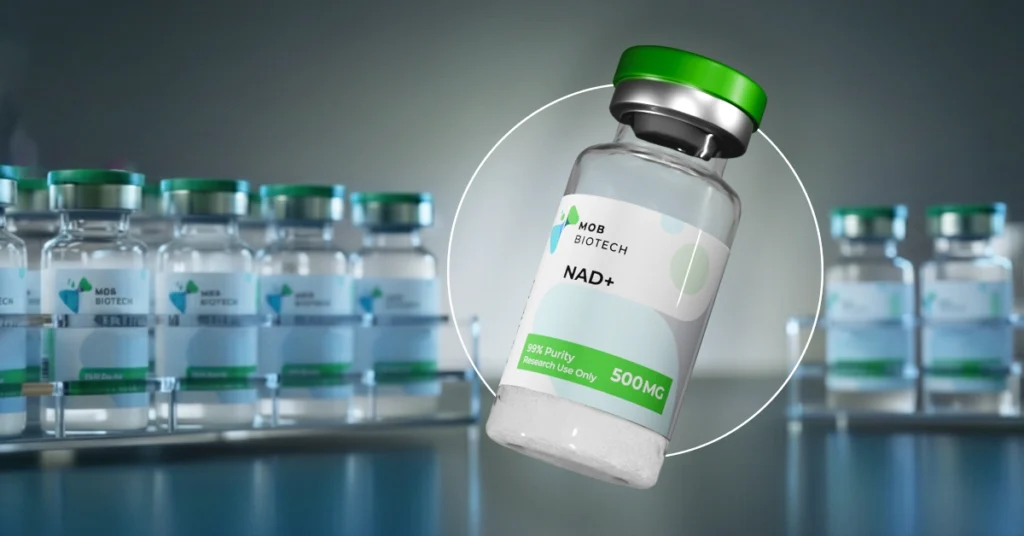You and I both know that the vast, complex universe of cellular biology is utterly dominated by a few core molecules that aren’t impressive for one single, niche function, but because they are foundational to almost every single operation within the cell. And if you’re a serious researcher, you already understand this truth: NAD+ (Nicotinamide Adenine Dinucleotide) is not merely a chemical that gently impacts a pathway; it is, quite literally, the entire pathway. So, if you haven’t already incorporated the vast, broader implications of NAD+ into your most critical research protocols, you might be overlooking an absolutely essential piece of the puzzle that is already driving the work of the top-tier labs forward. Why are they prioritizing it? Because they know NAD+—a ubiquitous, ancient coenzyme at the hub of metabolism and cellular activity—serves as both the key electron carrier in catabolic processes and the indispensable substrate for the essential enzymes that govern everything from gene expression and cellular maintenance to stress adaptation. You cannot hope to truly understand the root causes of cellular dysfunction and the processes of molecular health without this molecule.
What Is NAD+?
NAD+ (Nicotinamide Adenine Dinucleotide) is a crucial coenzyme found in every living cell. It comes in two forms: NAD+ (oxidized form) and NADH (reduced form). This reversible redox state is what makes it so vital to cellular metabolism. NAD+ is an electron shuttle, receiving electrons from one molecule and donating them to another in an ongoing cycle that powers everything from glycolysis to the electron transport chain.
Aside from its role in energy production, NAD+ is also a critical substrate for a category of enzymes known as the sirtuins and the poly-ADP-ribose polymerases (PARPs). Sirtuins are a category of NAD+-dependent deacetylases that regulate gene expression, inflammation, and stress responses in the cell. PARPs are involved in DNA repair and genome integrity. The dual function of NAD+ as a metabolic cofactor and a regulatory substrate makes it an integrative molecule for scientific investigation of the complicated interliaison among cellular energy, genetic health, and overall cellular well-being. Its multi-pathway actions make it a fascinating and multi-dimensional subject for detailed investigation.
What Research Models Are Investigating with NAD+
NAD+ central role in cell metabolism puts it at the forefront of immediate research in a wide range of models of study. Its applications revolve around a description of the underlying mechanisms that govern cellular aging and well-being:
✅ Cellular Metabolism of Energy: NAD+ is the foremost candidate for cellular respiration, glycolysis, and electron transport chain research. It provides a direct glimpse of energy production efficiency and the kinetics of ATP synthesis.
✅ Sirtuin and Gene Regulation: Researchers use NAD+ as a model to explore the function of sirtuin enzymes, which are critical for controlling gene expression, cellular stress response, and metabolic pathways.
✅ DNA Repair Mechanisms: NAD+ is a crucial substrate for PARP enzymes and hence a crucial factor in models investigating DNA repair, genome stability, and cellular resilience to genetic damage.
✅ Mitochondrial Function and Biogenesis: The peptide is a powerful tool for probing mitochondrial health because NAD+ levels are directly associated with mitochondrial biogenesis, effectiveness, and overall function.
These various fields of study present NAD+ as a cornerstone molecule for anyone who wishes to understand cellular functions on their most fundamental levels. It’s not one pathway, it’s the middle machinery that drives all cellular activity.
Why Leading Researchers Include It in Their Protocols
The consistent, high-demand fascination with NAD+ from leading research institutions is not coincidental. It’s a clear sign that serious scientists regard this molecule as an essential piece of kit. Other molecules come and go, but NAD+ has become an institution because its underlying premise is not for debate. It’s a form of scientific social proof: the highest-performing and most prominent institutions rely on its crisply defined activity and central role in cellular biology.
NAD+ is a cornerstone research in cell science. While some compounds take all the attention, NAD+ is the molecule quietly working behind the advance that is taking place in metabolism, aging, and disease modeling. The top researchers understand that the true value of a compound is in its scientific usefulness and reproducibility. They’ve already incorporated NAD+ into their basic protocols, where they’ve used it to push the frontiers of cellular and molecular science in ways that those who ignore it will never come to value.
What to Look for When Ordering NAD
Your integrity of research is directly proportional to the purity and consistency of your reagents. You can’t buy cheap when you are buying a starting material such as NAD+. You need a supplier who is as committed to the scientific method as you are. Find a vendor that sells:
- Certificate of Analysis (CoA) Authentication: Your final and initial guarantee is a complete and verifiable CoA. It must confirm the product’s identity, purity, and concentration.
- HPLC and Mass Spec Testing: Insist on third-party, unbiased testing by High-Performance Liquid Chromatography (HPLC) and Mass Spectrometry. This data is the definitive assurance of purity and structure integrity that you are working with a clean, pure product.
- US-Based Shipping: Buying from a US-based supplier ensures faster, more reliable delivery and provides assurance of meeting high standards for quality control.
- Transparent Sourcing: A scientific brand company will reveal its synthesis and quality control processes. Such transparency is proof of a commitment to scientific integrity.
- Account Tools and Rewards: A supplier who invests in customer relationships through tools like rewards programs and simple reordering demonstrates a commitment to long-term relationships and operational excellence.
MOB Biotech operates on these values. Our commitment to aggressive quality control and open sourcing enables you to focus on your research, confident that your materials are of the highest quality.
Why Some Laboratories Still Ignore It (and Why That’s a Mistake)
We’re not here to convince everyone. Our mission is to equip serious researchers with the tools they need for groundbreaking work. However, it’s worth considering why some labs still overlook this powerful molecule. They may be focusing on downstream effects without addressing the upstream cause, or simply lack a deep understanding of NAD+’s central role. This is a significant mistake.
By ignoring NAD+, researchers are negligently giving up a unique opportunity to explore the innermost core of cell life. They are falling behind other researchers who are already using this molecule to generate novel information in fields like metabolism, aging, and neurobiology. The loss here is palpable: the loss of competitive advantage, the loss of pioneering knowledge, and the loss of an emerging tool already reaping invaluable returns. Do not let your lab be the one to discover these basic principles years before your competition.
Where NAD+ Fits in the Research Landscape
NAD+’s central position in cellular function makes it an excellent candidate for a variety of key fields of inquiry, as a powerful agent to help understand complex biological processes:
📌 Metabolic Modulation: It is a key component of models that study metabolic flexibility, energy use, and regulation of catabolic and anabolic processes.
📌 Health and Longevity of the Cell: Researchers utilize NAD+ in understanding the aging process, as its levels play a pivotal role in setting sirtuin activity and cellular maintenance.
📌 Neurological Pathways: NAD+ is a key component used to learn more about neurodegeneration and brain health since its levels are vital in preserving the functionality of neurons and protecting against stress.
📌 Genome Integrity and DNA Repair: The molecule’s use as a substrate by PARPs makes it a critical component in the study of DNA damage, genetic stability, and the cellular response to environmental stress.
📌 Mitochondrial Function: NAD+ is a cornerstone for every study of mitochondrial dynamics, biogenesis, and function.
NAD+ is often co-administered with precursors like NMN and NR to explore the effects of modifying its levels, and other peptides like MOTS-c to create more advanced models investigating the intricate interaction between mitochondrial well-being and overall cellular function.
Last Word on NAD+
NAD+ is not just a coenzyme; it’s a core molecule that continues to unlock the secrets of cellular life. Its flexibility and reliability have made it an essential instrument for scientists dedicated to expanding their research in metabolism, aging, and molecular biology. Don’t let this powerful molecule get away from your lab.
Find batch-tested NAD+ at MOB Biotech.
🧬 US-Based. CoA-Backed. Awards on every purchase.
👉 Find NAD+ at MOB Biotech

